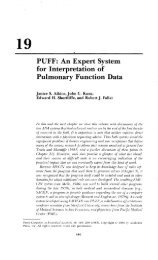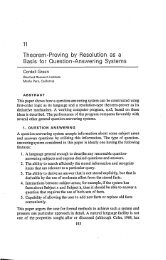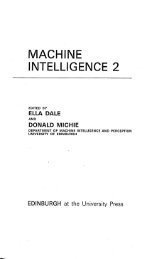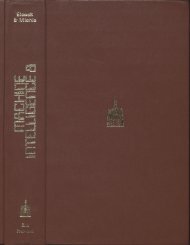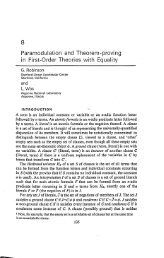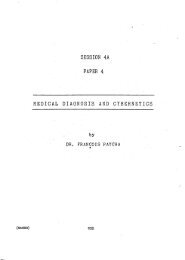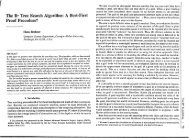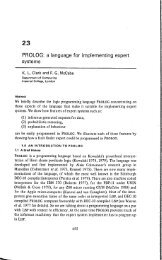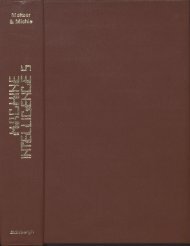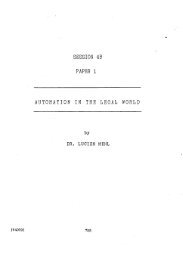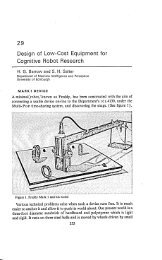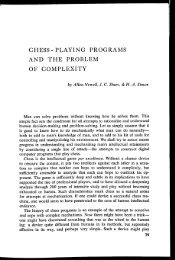- Page 1 and 2: 114; tt.t. 1 s
- Page 3: MACHINE INTELLIGENCE 7
- Page 6 and 7: © 1972 Edinburgh University Press
- Page 8 and 9: PREFACE the speed of calculation is
- Page 10 and 11: PREFACE them on the shelves until t
- Page 13 and 14: CONTENTS INTRODUCTION xiii PREHISTO
- Page 15 and 16: INTRODUCTION Among the many propert
- Page 17: PREHISTORY
- Page 20 and 21: PREHISTORY discussion of the later
- Page 22 and 23: PREHISTORY beginning to wane. I eve
- Page 24 and 25: PREHISTORY I don't think that I can
- Page 26 and 27: PREHISTORY discouraged by the slown
- Page 28 and 29: PREHISTORY carried some fixed patte
- Page 30 and 31: PREHISTORY After completing actuari
- Page 32 and 33: PREHISTORY modified program cards,
- Page 36 and 37: PREHISTORY and they were joined in
- Page 39 and 40: Some Techniques for Proving Correct
- Page 41 and 42: BURSTALL (a, j)+ 1), treating array
- Page 43 and 44: IIURSTALL a'(0> 0. The distinction
- Page 45 and 46: BURSTALL that a is a list from u to
- Page 47 and 48: BURSTALL • j =RE VER S E(k) Assum
- Page 49 and 50: BURSTALL j=REVERSE(k) Assume rev: (
- Page 51 and 52: • BURSTALL Assume n, Ai,.. ., An,
- Page 53 and 54: BURSTALL (iii) If E is 11E1 and D c
- Page 55 and 56: BURSTALL j=CYCLICREVERSE(1) (*(/->n
- Page 57 and 58: BURSTALL Our previous discussion de
- Page 59 and 60: BURSTALL Taking the case where f2 c
- Page 61 and 62: 13URSTALL In the case of cons and a
- Page 63 and 64: 13URSTALL k=SUBST(i, a, j). Substit
- Page 65 and 66: BURSTALL Eilenberg, S. & Wright, J.
- Page 67 and 68: 3 Proving Compiler Correctness in a
- Page 69 and 70: MILNER AND WEYHRAUCII and q, else r
- Page 71 and 72: MILNER AND WEYHRAUCH We use `8e for
- Page 73 and 74: I MILNER AND WEYHRAUCH ((JF&(count(
- Page 75 and 76: MILNER AND WEYIIRAUCH (iii) For eac
- Page 77 and 78: MILNER AND WEYHRAUCII We have abbre
- Page 79 and 80: MILNER AND WEYHRAUCH give us a feel
- Page 81 and 82: MILNER AND WEYIIRAUCII APPENDIX 1:
- Page 83 and 84: .71 APPENDIX 3: proof of the McCart
- Page 85 and 86:
HDIIVIEHA3M CENIV 11UNIITAI I 1 1 1
- Page 87:
COMPUTATIONAL LOGIC
- Page 90 and 91:
COMPUTATIONAL LOGIC N((±)P(ti, t
- Page 92 and 93:
COMPUTATIONAL LOGIC (3) Find the di
- Page 94 and 95:
COMPUTATIONAL LOGIC are number term
- Page 96 and 97:
COMPUTATIONAL LOGIC A set of litera
- Page 98 and 99:
COMPUTATIONAL LOGIC Conditions 4 an
- Page 100 and 101:
COMPUTATIONAL LOGIC In our opinion,
- Page 102 and 103:
COMPUTATIONAL LOGIC Theorem 3. If S
- Page 104 and 105:
COMPUTATIONAL LOGIC and V. and furt
- Page 106 and 107:
COMPUTATIONAL LOGIC Kowalski, R.K.
- Page 108 and 109:
COMPUTATIONAL LOGIC another. It is
- Page 110 and 111:
COMPUTATIONAL LOGIC how the effect
- Page 112 and 113:
COMPUTATIONAL LOGIC The enlarged al
- Page 114 and 115:
COMPUTATIONAL LOGIC being within Pr
- Page 117 and 118:
6 The Sharing of Structure in Theor
- Page 119 and 120:
BOYER AND MOORE of a substitution S
- Page 121 and 122:
BoYER AND MOORE Otherwise TERM is n
- Page 123 and 124:
BOYER AND MOORE binding environment
- Page 125 and 126:
BOYER AND MOORE TERMB,INDEXB in the
- Page 127 and 128:
BOYER AND MOORE set INDEXB to INDEX
- Page 129 and 130:
H110011 CINV /13A0£1 21 .V, - cs'
- Page 131 and 132:
BOYER AND MOORE UNIFY can be made t
- Page 133 and 134:
7 Some Special Purpose Resolution S
- Page 135 and 136:
KUEHNER resolvent in D. Let C1 and
- Page 137 and 138:
KUEHNER obtained by deleting the gi
- Page 139 and 140:
KUEHNER D be any sPu-refutation of
- Page 141 and 142:
KUEHNER BI-DIRECTIONAL SPU/SNL RESO
- Page 143 and 144:
KUEHNER of finding a refutation of
- Page 145 and 146:
8 Deductive Plan Formation in Highe
- Page 147 and 148:
DARLINGTON and `c3' are set variabl
- Page 149 and 150:
DARLINGTON submitted to our theorem
- Page 151 and 152:
DARLINGTON Some further problems wh
- Page 153:
DARLINGTON Hewitt, C. (1971). Proce
- Page 157 and 158:
9 G-deduction D. Michie, R. Ross an
- Page 159 and 160:
MICIIIE, ROSS AND SHANNAN Search oc
- Page 161 and 162:
MICHIE, ROSS AND SHANNAN root node
- Page 163 and 164:
MICHIE, ROSS AND SHANNAN Positive c
- Page 165 and 166:
MICHIE, ROSS AND SHANNAN mere insta
- Page 167 and 168:
MICHIE, ROSS AND SHANNAN G-deduct i
- Page 169 and 170:
MICHIE, ROSS AND SHANNAN (4) additi
- Page 171 and 172:
MICHIE, ROSS AND SHANNAN (4) repres
- Page 173 and 174:
MICHIE, ROSS AND SHANNAN completene
- Page 175 and 176:
MICHIE, ROSS AND SHANNAN RESULTS Th
- Page 177 and 178:
MICHIE, ROSS AND SIIANNAN and, more
- Page 179 and 180:
• MICHIE, ROSS AND SHANNAN DM {{P
- Page 181:
S a Skolem constant T THERE Variabl
- Page 184 and 185:
INFERENTIAL AND HEURISTIC SEARCH se
- Page 186 and 187:
INFERENTIAL AND HEURISTIC SEARCH 0
- Page 188 and 189:
INFERENTIAL AND HEURISTIC SEARCH in
- Page 190 and 191:
INFERENTIAL AND HEURISTIC SEARCH no
- Page 192 and 193:
INFERENTIAL AND HEURISTIC SEARCH Re
- Page 194 and 195:
INFERENTIAL AND HEURISTIC SEARCH th
- Page 196 and 197:
INFERENTIAL AND HEURISTIC SEARCH be
- Page 198 and 199:
INFERENTIAL AND HEURISTIC SEARCH h
- Page 200 and 201:
INFERENTIAL AND HEURISTIC SEARCH so
- Page 202 and 203:
INFERENTIAL AND HEURISTIC SEARCH BI
- Page 204 and 205:
INFERENTIAL AND HEURISTIC SEARCH FI
- Page 206 and 207:
INFERENTIAL AND HEURISTIC SEARCH Em
- Page 208 and 209:
INFERENTIAL AND HEURISTIC SEARCH ob
- Page 210 and 211:
INFERENTIAL AND HEURISTIC SEARCH Co
- Page 212 and 213:
INFERENTIAL AND HEURISTIC SEARCH mo
- Page 214 and 215:
INFERENTIAL AND HEURISTIC SEARCH EP
- Page 216 and 217:
INFERENTIAL AND HEURISTIC SEARCH TH
- Page 218 and 219:
INFERENTIAL AND HEURISTIC SEARCH in
- Page 220 and 221:
INFERENTIAL AND HEURISTIC SEARCH Sa
- Page 222 and 223:
INFERENTIAL AND HEURISTIC SEARCH 10
- Page 224 and 225:
INFERENTIAL AND HEURISTIC SEARCH no
- Page 226 and 227:
INFERENTIAL AND HEURISTIC SEARCH (a
- Page 228 and 229:
INFERENTIAL AND HEURISTIC SEARCH in
- Page 230 and 231:
• • 0 • • • KO • •
- Page 232 and 233:
INFERENTIAL AND HEURISTIC SEARCH an
- Page 234 and 235:
• INFERENTIAL AND HEURISTIC SEARC
- Page 236 and 237:
INFERENTIAL AND HEURISTIC SEARCH (a
- Page 238 and 239:
INFERENTIAL AND HEURISTIC SEARCH th
- Page 240 and 241:
• INFERENTIAL AND HEURISTIC SEARC
- Page 242 and 243:
INFERENTIAL AND HEURISTIC SEARCH °
- Page 244 and 245:
—AO INFERENTIAL AND HEURISTIC SEA
- Page 246 and 247:
• • • A • • 0 • • •
- Page 248 and 249:
INFERENTIAL AND HEURISTIC SEARCH pr
- Page 250 and 251:
• • • • • INFERENTIAL AND
- Page 252 and 253:
INFERENTIAL AND HEURISTIC SEARCH 5
- Page 254 and 255:
INFERENTIAL AND HEURISTIC SEARCH di
- Page 256 and 257:
,0* INFERENTIAL AND HEURISTIC SEARC
- Page 258 and 259:
INFERENTIAL AND HEURISTIC SEARCH cr
- Page 260 and 261:
INFERENTIAL AND HEURISTIC SEARCH se
- Page 262 and 263:
INFERENTIAL AND HEURISTIC SEARCH th
- Page 264 and 265:
INFERENTIAL AND HEURISTIC SEARCH Tr
- Page 266 and 267:
INFERENTIAL AND HEURISTIC SEARCH ex
- Page 268 and 269:
INFERENTIAL AND HEURISTIC SEARCH 2.
- Page 270 and 271:
INFERENTIAL AND HEURISTIC SEARCH CO
- Page 272 and 273:
INrERENTIAL AND HEURISTIC SEARCH Ta
- Page 274 and 275:
• 0.00 1.00 2.00 3.00 4.00 Figure
- Page 276 and 277:
• to School 1 hool ,----- \ 4,% 3
- Page 278 and 279:
INFERENTIAL AND HEURISTIC SEARCH 8
- Page 280 and 281:
INFERENTIAL AND HEURISTIC SEARCH 8
- Page 282 and 283:
INFERENTIAL AND HEURISTIC SEARCH Ob
- Page 284 and 285:
INFERENTIAL AND HEURISTIC SEARCH th
- Page 286 and 287:
INFERENTIAL AND HEURISTIC SEARCH Sp
- Page 288 and 289:
INFERENTIAL AND HEURISTIC SEARCH th
- Page 290 and 291:
INFERENTIAL AND HEURISTIC SEARCH (i
- Page 292 and 293:
INFERENTIAL AND HEURISTIC SEARCH 12
- Page 294 and 295:
INFERENTIAL AND HEURISTIC SEARCH Ta
- Page 296 and 297:
INFERENTIAL AND HEURISTIC SEARCH Ta
- Page 298 and 299:
INFERENTIAL AND HEURISTIC SEARCH an
- Page 300 and 301:
INFERENTIAL AND IIEURISTIC SEARCH B
- Page 302 and 303:
INFERENTIAL AND HEURISTIC SEARCH Co
- Page 304 and 305:
INFERENTIAL AND HEURISTIC SEARCH of
- Page 306 and 307:
INFERENTIAL AND HEURISTIC SEARCH th
- Page 309 and 310:
15 Mathematical and Computational M
- Page 311 and 312:
FRIEDMAN from base tree to surface
- Page 313 and 314:
FRIEDMAN Who did Jack find out that
- Page 315 and 316:
FRIEDMAN only. All computer runs we
- Page 317 and 318:
FRIEDMAN control program can be wri
- Page 319 and 320:
FRIEDMAN APPENDIX A "COMPUTER EXPER
- Page 321 and 322:
FRIEDMAN APPENDIX B "COMPUTER EXPER
- Page 323 and 324:
16 Web Automata and Web Grammars A.
- Page 325 and 326:
ROSENFELD AND MILGRAM (4) co' is ob
- Page 327 and 328:
ROSENFELD AND MILGRAM is applied, p
- Page 329 and 330:
ROSENFELD AND MILGRAM 7 I'S 0(Y, Y)
- Page 331 and 332:
ROSENFELD AND MILGRAM (5) If the ab
- Page 333 and 334:
ROSENFELD AND MILGRAM 3.4 Web gramm
- Page 335 and 336:
ROSENFELD AND MILGRAM where (11) ap
- Page 337 and 338:
ROSENFELD AND MILGRAM (d) Nog={ml,m
- Page 339 and 340:
ROSENFELD AND MILGRAM out that the
- Page 341 and 342:
17 Utterances as Programs D. J. M.
- Page 343 and 344:
DAVIES AND ISARD complex situation
- Page 345 and 346:
DAVIES AND ISARD and PLANNER (Hewit
- Page 347 and 348:
DAVIES AND ISARD which are consider
- Page 349 and 350:
DAVIES AND ISARD questions, and the
- Page 351 and 352:
DAVIES AND ISARD To help clarify ou
- Page 353 and 354:
DAVIES AND ISARD numbername(term(un
- Page 355:
DAVIES AND ISARD and a command, we
- Page 358 and 359:
PERCEPTUAL AND LINGUISTIC MODELS sl
- Page 360 and 361:
PERCEPTUAL AND LINGUISTIC MODELS 2.
- Page 362 and 363:
PERCEPTUAL AND LINGUISTIC MODELS an
- Page 364 and 365:
PERCEPTUAL AND LINGUISTIC MODELS 4.
- Page 366 and 367:
PERCEPTUAL AND LINGUISTIC MODELS (f
- Page 368 and 369:
PERCEPTUAL AND LINGUISTIC MODELS It
- Page 370 and 371:
PERCEPTUAL AND LINGUISTIC MODELS Le
- Page 372 and 373:
PERCEPTUAL AND LINGUISTIC MODELS He
- Page 374 and 375:
PERCEPTUAL AND LINGUISTIC MODELS ha
- Page 376 and 377:
PERCEPTUAL AND LINGUISTIC MODELS Th
- Page 378 and 379:
PERCEPTUAL AND LINGUISTIC MODELS wh
- Page 380 and 381:
PERCEPTUAL AND LINGUISTIC MODELS jo
- Page 382 and 383:
PERCEPTUAL AND LINGUISTIC MODELS Fi
- Page 385 and 386:
20 Approximate Error Bounds in Patt
- Page 387 and 388:
ITO (1) Proof of Pe ‹. Q„ We co
- Page 389 and 390:
ITO Q0=1-11 p(x)[p(ci I x)- p(c21x)
- Page 391 and 392:
ITO Thus we have proved eq. (49). U
- Page 393 and 394:
21 A Look at Biological and Machine
- Page 395 and 396:
GREGORY logical operations than are
- Page 397 and 398:
GREGORY no created contours, althou
- Page 399 and 400:
GREGORY black and the white illusor
- Page 401:
GREGORY appear trivial. There is no
- Page 405 and 406:
22 Some Effects in the Collective B
- Page 407 and 408:
VARSHAVSKY The set of automorphisms
- Page 409 and 410:
VARSHAVSKY that after each play of
- Page 411 and 412:
VARSHAVSKY do not use recessive str
- Page 413 and 414:
VARSHAVSKY M,\ M" .... - 397 Figure
- Page 415 and 416:
VARSHAVSKY Figure 2 I automata-- 1
- Page 417 and 418:
Forming the balance equation, we ha
- Page 419 and 420:
VARSHAYSKY This obviously suggests
- Page 421:
VARSHAVSKY This obviously suggests
- Page 424 and 425:
PROBLEM-SOLVING AUTOMATA be related
- Page 426 and 427:
, PROBLEM-SOLVING AUTOMATA either t
- Page 428 and 429:
PROBLEM-SOLVING AUTOMATA room; thus
- Page 430 and 431:
PROBLEM-SOLVING AUTOMATA Execution
- Page 432 and 433:
PROBLEM-SOLVING AUTOMATA as PLANNER
- Page 434 and 435:
PROBLEM-SOLVING AUTOMATA Table I. E
- Page 436 and 437:
PROBLEM-SOLVING AUTOMATA probably b
- Page 438 and 439:
PROBLEM-SOLVING AUTOMATA expanded w
- Page 440 and 441:
PROBLEM-SOLVING AUTOMATA extent tha
- Page 442 and 443:
PROBLEM-SOLVING AUTOMATA actions of
- Page 444 and 445:
PROBLEM-SOLVING AUTOMATA The algori
- Page 446 and 447:
PROBLEM-SOLVING AUTOMATA interest.
- Page 448 and 449:
PROBLEM-SOLVING AUTOMATA be that AI
- Page 450 and 451:
PROBLEM-SOLVING AUTOMATA Finally a
- Page 452 and 453:
PROBLEM-SOLVING AUTOMATA advantage.
- Page 454 and 455:
PROBLEM-SOLVING AUTOMATA Why should
- Page 456 and 457:
PROBLEM-SOLVING AUTOMATA A line in
- Page 458 and 459:
PROBLEM-SOLVING AUTOMATA places whe
- Page 460 and 461:
PROBLEM-SOLVING AUTOMATA scene. But
- Page 462 and 463:
PROBLEM-SOLVING AUTOMATA 4. The sys
- Page 464 and 465:
PROBLEM-SOLVING AUTOMATA Let me see
- Page 466 and 467:
PROBLEM-SOLVING AUTOMATA LEARNING T
- Page 468 and 469:
PROBLEM-SOLVING AUTOMATA pedestal n
- Page 470 and 471:
PROBLEM-SOLVING AUTOMATA relationsh
- Page 472 and 473:
PROBLEM-SOLVING AUTOMATA relations.
- Page 474 and 475:
PROBLEM-SOLVING AUTOMATA program bo
- Page 476 and 477:
PROBLEM-SOLVING AUTOMATA MOVE. To m
- Page 478 and 479:
PROBLEM-SOLVING AUTOMATA CHOOSE-TO-
- Page 480 and 481:
PROBLEM-SOLVING AUTOMATA Moving in
- Page 483 and 484:
25 The Mark 1.5 Edinburgh Robot Fac
- Page 485 and 486:
BARROW AND CRAWFORD or more element
- Page 487 and 488:
BARROW AND CRAWFORD reduce this to
- Page 489 and 490:
BARROW AND CRAWFORD SATELLITE COMPU
- Page 491 and 492:
BARROW AND CRAWFORD DATA READY ACCE
- Page 493 and 494:
BARROW AND CRAWFORD or contents alt
- Page 495 and 496:
movETo(x, y); BARROW AND CRAWFORD p
- Page 497 and 498:
BARROW AND CRAWFORD are performed b
- Page 499 and 500:
INDEX Abe 307, 323 ACE 3, 4, 6, 10,
- Page 501 and 502:
Jensen 78, 132 Johnson 245 Jordan 1
- Page 503:
Steinberg 247 Stephenson 367 Strach



